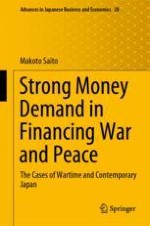
2021 | OriginalPaper | Chapter
Introduction: Toward a Monetary and Fiscal Theory of the Price Level
Author : Makoto Saito
Published in: Strong Money Demand in Financing War and Peace
Publisher: Springer Singapore
Activate our intelligent search to find suitable subject content or patents.
Select sections of text to find matching patents with Artificial Intelligence. powered by
Select sections of text to find additional relevant content using AI-assisted search. powered by